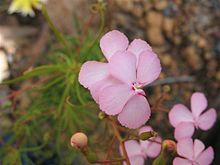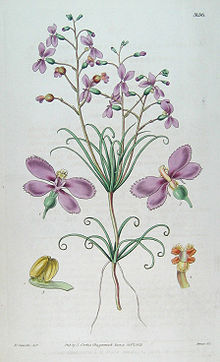
Stylidium is a genus of dicotyledonous plants that belong to the family Stylidiaceae. The genus name Stylidium is derived from the Greek στύλος or stylos, which refers to the distinctive reproductive structure that its flowers possess. Pollination is achieved through the use of the sensitive "trigger", which comprises the male and female reproductive organs fused into a floral column that snaps forward quickly in response to touch, harmlessly covering the insect in pollen. Most of the approximately 300 species are only found in Australia, making it the fifth largest genus in that country. Triggerplants are considered to be protocarnivorous or carnivorous because the glandular trichomes that cover the scape and flower can trap, kill, and digest small insects with protease enzymes produced by the plant. Recent research has raised questions as to the status of protocarnivory within Stylidium.
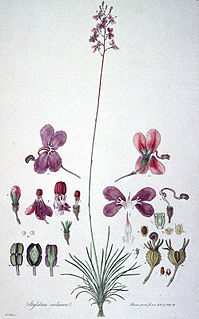
Stylidium violaceum, the violet triggerplant, is a dicotyledonous plant that belongs to the genus Stylidium. S. violaceum is endemic to Australia and is found primarily in the southwestern region of Western Australia. It can grow up to 50 cm including the scape. The mostly purple flowers are 10 mm tall and 6 mm broad. Leaves are 5 cm long and about 4 mm broad. Flowering occurs mainly from October to January. S. violaceum is found in locations with sandy or loamy sand soil texture conditions on hillslopes, dunes, or winter wet depressions and swamps.

Stylidium adnatum is a dicotyledonous plant that belongs to the genus Stylidium. S. adnatum is endemic to Australia and is found primarily in the southwest region of Western Australia.

Stylidium repens, the matted triggerplant, is a dicotyledonous plant that belongs to the genus Stylidium. S. repens is endemic to Australia and is found primarily in southwest Western Australia. This species is a creeping or scrambling triggerplant, which can spread over large areas as a tangled mat of stems and aerial roots. The older stems are grey whereas younger stems appear red and have terminal rosettes of small leaves, five mm to one cm in length. When the rains come, new roots and a one to three flowers emerge from the terminal rosettes. This is the only species of triggerplant known to regularly flower twice a year—in autumn and late spring. Pollination, which is typically very specialized in this genus, is achieved with a variety of insects in this species.
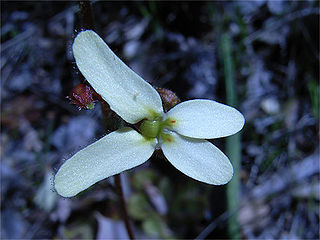
Stylidium hispidum, the white butterfly triggerplant, is a dicotyledonous plant that belongs to the genus Stylidium. S. hispidum is endemic to Australia and is found primarily in southwest Western Australia near Perth. This species is a basally rosetted triggerplant with greyish, linear leaves growing up to three cm. The scape is reddish, from six to thirty cm tall ending in a somewhat branched raceme giving rise to white or cream-colored flowers, which have red spots near the throat of the flower. The primary habitat for S. hispidum includes jarrah forests, gravelly loams, and light sandy soils.

Stylidium graminifolium, the grass triggerplant, is a dicotyledonous plant that belongs to the genus Stylidium. This species used to belong to the Stylidium graminifolium complex, but the name was conserved for this single species when two others were split from the complex and introduced as new species in 2001. S. graminifolium is endemic to Australia and is one of the Stylidium species with the widest distribution throughout Australia. It is a perennial plant with grass-like leaves and is easily cultivated. It has been considered to be a carnivorous or protocarnivorous plant because it possesses glandular trichomes underneath the flowers that can trap and digest prey.
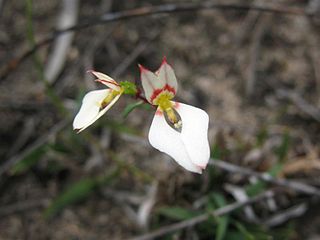
Levenhookia, also known as the styleworts, is a genus of ten recognized species in the family Stylidiaceae and is endemic to Australia. The genus is restricted to Western Australia almost exclusively with a few exceptions: L. pusilla's range extends into South Australia, L. dubia's range extends through South Australia into Victoria and New South Wales, L. sonderi is native only to Victoria, and L. chippendalei is also found in the Northern Territory.
Stylidium aceratum is a dicotyledonous plant that belongs to the genus Stylidium. It occurs within the south west region of Western Australia
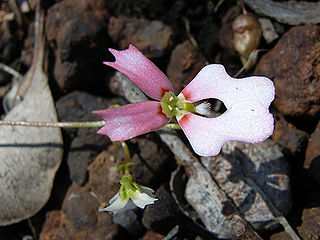
Stylidium calcaratum, the book triggerplant, is a dicotyledonous plant that belongs to the genus Stylidium. It is an ephemeral annual that grows from 5 to 10 cm tall but can grow larger at 20–30 cm tall in damp forest or scrub habitat. The few ovate leaves produced by this plant form basal rosettes around the stem. The leaves are around 3–5 mm long on short petioles. The scapes are 2–30 cm tall and produce single flowers in smaller plants and up to nine flowers in larger, more robust plants. Flowers are pink or white with red spots or lines at the individual petal bases. The petals are vertically paired and will fold over to meet each other at night or in adverse weather conditions. S. calcaratum is endemic to Australia and has a distribution that ranges from Victoria through South Australia and into Western Australia. Its habitat is recorded as being wet flats or near creeks and seepages. Pollination is achieved by a grey fly, Comptosia cuneata.
Stylidium ceratophorum is a dicotyledonous plant that belongs to the genus Stylidium. It is an annual plant that is endemic to the Kimberley region of Western Australia and northern parts of the Northern Territory. It attains a height of 12–30 cm with a basal rosette of small leaves. The leaves are petiolate, obovate, or lanceolate and are only 0.2–1 cm long. Solitary scapes are produced that bear golden yellow or orange flowers, 7–9 mm across. Its habitat has been reported as being sandy soils on creek margins in the presence of Stylidium rubriscapum and Stylidium diceratum or in river paperbark stands. S. ceratophorum appears similar to S. diceratum and may be confused with the species since they both have orange flowers. S. ceratophorum's corolla is twice as large as S. diceratum, though, as well as the deeply divided posterior corolla lobes of S. ceratophorum.
Stylidium edentatum is a dicotyledonous plant that belongs to the genus Stylidium. It is an annual plant that grows around 6 cm tall. The elliptical leaves form a basal rosettes around the stem. The leaves are around 0.3-0.8 mm long with recurved margins. Inflorescences are produced on solitary scapes and bear flowers that are white with rose-coloured markings at the base of the corolla lobes and two tooth-shaped throat appendages present. S. edentatum was a previously overlooked species that is related to and appears similar to S. calcaratum and S. ecorne. Allen Lowrie and Sherwin Carlquist described this species in 1989 and argued that if S. ecorne is considered distinct from S. calcaratum, then certainly S. edentatum warrants placement at the species level. It differs from S. calcaratum and S. ecorne by the long petioles on its recurved leaves, and the cuneate, obtuse, and unlobed posterior corolla lobes. They also have a distinctive lateral toothlike appendage at the base of each posterior corolla lobe. S. edentatum is endemic to southwestern Western Australia.

Stylidium perpusillum, the tiny triggerplant, is a dicotyledonous plant that belongs to the genus Stylidium, that occurs in south west Western Australia.
Stylidium weeliwolli is a dicotyledonous plant that belongs to the genus Stylidium. It occurs in the North West of Western Australia
Stylidium inaequipetalum, the Ayers Rock triggerplant, is a small herbaceous perennial plant in the genus Stylidium. It grows from 7 to 40 cm tall. Oblanceolate leaves, about 20-100 per plant, form a basal rosette with stems absent. The leaves are generally 15–81 mm long and 2–8 mm wide. This species produces 1-11 scapes per plant. Inflorescences are 7–40 cm long and produce pink flowers with petals all free and blooms almost year-round in their native range. S. inaequipetalum is endemic to the southwestern Northern Territory and Western Australia. Its typical habitat has been reported as sandy soils on sheltered creekbanks or in between rocks. S. inaequipetalum is most closely related to S. floribundum, though it is also closely allied with S. debile.

Stylidium rupestre is a dicotyledonous plant that belongs to the genus Stylidium, a species sometimes named as the rock triggerplant. It is found in Southwest Australia. The species was first described by Otto Wilhelm Sonder.

Stylidium spathulatum is a dicotyledonous plant that belongs to the genus Stylidium. The species is informally named the creamy triggerplant for the colour of its flowers.

Stylidium nymphaeum is a climbing triggerplant found along the southern coast of Southwest Australia. The species uses the curved tips of its leaves to clamber over nearby plants, attaining a height between 1.4 and 2.5 metres. These leaves are long and slender, between 15 and 75 millimetres in length and 0.8 to 2 millimetres in width, are hairless, and have an entire margin. The scape is also hairless. The flowers are pink to purple, appearing from December or January to May.
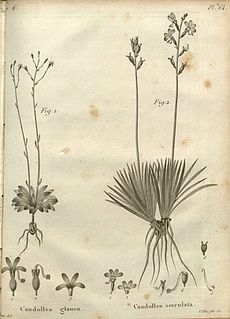
Stylidium glaucum, the grey triggerplant, is a herbaceous plant found along the southern coast of Southwest Australia, West of Albany. The plant attains a height between 0.15 and 0.65 metres. The leaves are lanceolate in form, becoming pointed at the base, and moderately acute at the tip. These are between 20 and 70 millimetres in length and 2 to 9 millimetres in width, are hairless, and have an entire margin. The trivial name of the species, glaucum, refers to the greyish colour of the leaves. The scape is hairless, supporting a racemose arrangement of white or pink flowers that appear from January to May.
